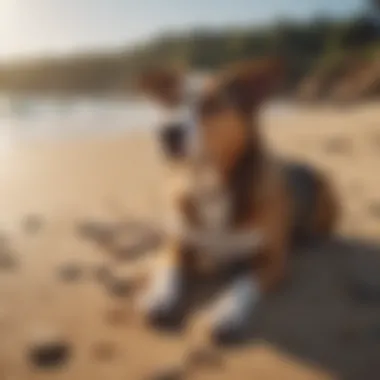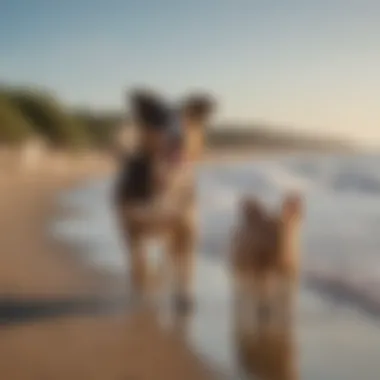Taking Your Dog to the Beach: A Complete Guide


Intro
Taking your dog to the beach for the first time can be both an exciting and daunting experience. Proper preparation can significantly impact how much enjoyment both you and your furry companion get from the trip. This guide discusses various aspects to consider before hitting the sandy shores. Each section provides insight into the necessary planning, safety protocols, and socialization techniques that will result in a rewarding outing.
Alongside fun activities, it's essential to focus on your pet's care and needs. Understanding how to keep your dog safe and comfortable at the beach will relieve some stress and improve the overall experience. In this guide, we will walk through every crucial step, ensuring your beach day is memorable.
Pet Care and Grooming
Before stepping onto the beach, understanding your dog's grooming and care regimen is vital. Regular care has a direct impact on a dog’s health, especially in a new environment such as the beach. This includes not only grooming but also ensuring they are in good condition for this type of outing.
Importance of Regular Care
Consistent care helps maintain your dog's fur and skin. Sand, saltwater, and sun can cause irritation or discomfort if your dog's coat is not well maintained. Additionally, regular grooming becomes crucial before already engaging in active beach play.
Grooming Techniques by Pet Type
Different dog breeds have varied grooming needs. For example, long-haired breeds like Golden Retrievers require thorough brushing to prevent mats from forming due to sand. In contrast, short-haired breeds may not need as much attention. Always consider the specific requirements of your dog's coat type.
Tools and Products Recommendations
To ensure effective grooming, consider the following tools:
- Slicker Brushes: Great for removing loose hairs and debris.
- Deshedding Tools: Useful for breeds that shed heavily.
- Dog Shampoo: Use a gentle, dog-specific formula to wash off sand and salt after your beach visit.
Seasonal Care Tips
In summer, protecting your dog from excessive sun exposure is important. Consider using pet-safe sunscreen on exposed areas like the nose and ears. Always provide ample shade and fresh water. Remember that dogs can overheat, so supervision is crucial.
Regular grooming and effective care can prevent many discomforts your pet may face at the beach.
Health and Nutrition
It is equally important to address your dog's health and nutrition in preparation for a beach outing. A healthy dog is better equipped to handle the rigors of running on sand and swimming in the ocean.
Understanding Pet Nutrition
Before going to the beach, ensure your dog is on a suitable diet. Proper nutrition directly influences their energy levels and overall health. Consult your veterinarian for dietary advice suited to your dog's breed and age.
Common Health Issues by Species
Be aware of any breed-specific health concerns. For instance, brachycephalic breeds may struggle with breathing in hot weather. Recognizing potential issues helps mitigate risks during your beach visit.
Preventive Care and Regular Check-Ups
Taking your dog for regular veterinary check-ups allows for early detection of health issues. A clean bill of health can provide peace of mind before embarking on new adventures.
Food and Dietary Advice
Always pack the right food and treats for your beach trip. Ensure your dog stays hydrated, and consider bringing a portable water dish to make it convenient for them to drink.
Behavioral Training
Training is essential before introducing your dog to a new environment. Feeling confident in your dog's behavior can greatly enhance the experience.
Basics of Positive Reinforcement
Utilizing positive reinforcement techniques can aid in establishing good behavior at the beach. Rewarding your dog for obeying commands reduces the chances of undesirable behaviors.
Training Techniques Users Can Apply


Practice commands such as
Understanding the Importance of the First Beach Experience
Taking your dog to the beach for the first time is significant for both the owner and the pet. This experience can shape how your dog perceives new environments. A positive introduction can encourage curiosity and confidence. It is essential to create a supportive atmosphere. The beach offers a unique opportunity for socialization and stimulation. Dogs can explore diverse sounds, smells, and sights, which can enhance their cognitive skills.
Benefits of Introducing Your Dog to the Beach
Introducing your dog to the beach brings several benefits. Firstly, it allows dogs to engage in physical exercise. Running on the sand or swimming in water can improve their overall health. Secondly, the variety of textures and sensations helps with sensory enrichment. The sound of waves may also provide auditory stimulation. This can be helpful for dogs that may be anxious in other settings.
Additionally, the beach is a great place for socialization. Your dog can meet other dogs and people. Positive experiences in these interactions can lead to better behavior in public settings. Moreover, a beach visit can strengthen the bond between you and your dog. Sharing new experiences together can build trust and affection. Overall, these factors contribute to a well-rounded, happy dog.
Potential Challenges and Risks
Despite the benefits, potential challenges exist. One risk is the possibility of overheating. Dogs can quickly become too hot, especially in sunny weather. It is crucial to monitor their behavior and provide shade and water. Another concern is the exposure to unfamiliar environments. For some dogs, this may cause stress or fear. Gradual exposure to the beach can help them adjust more comfortably.
Also, not all beaches are dog-friendly. Local regulations can vary greatly, leading to restrictions for pets. It is important to research ahead of time. Things like riptides and strong currents can also pose dangers. Understanding these risks helps ensure a safe experience.
Ultimately, knowing how to introduce your dog to the beach responsibly is crucial for fostering a harmonious relationship and ensuring a positive experience.
Preparing for a Beach Visit
Planning for your dog's first visit to the beach is a critical step that can greatly impact the overall experience. Proper preparation helps to mitigate risks and ensures that both you and your dog have an enjoyable day by the ocean. This section will cover essential aspects, from gear selection to timing your visit, each contributing to a successful introduction to a beach environment.
Essential Gear for Your Dog
Having the right gear is crucial for your dog's comfort and safety on the beach. Here are some items you should consider bringing:
- Leash and Harness: A sturdy leash and well-fitting harness are indispensable. They help maintain control over your dog, especially in busy areas with other people and pets.
- Water and Bowl: Dogs can easily become dehydrated in the heat. Bring plenty of fresh water and a portable bowl for your dog to drink from regularly.
- Dog Sunscreen: Just like humans, dogs need protection from UV rays. Look for a canine-safe sunscreen to apply on your dog's nose and ears.
- Towels: Bring towels for drying your dog off after swimming or playing in the water. They also come in handy if your dog rolls in sand or mud.
- First Aid Kit: Having a basic first aid kit for pets can be beneficial in case of minor injuries or irritations caused by sand or saltwater.
When choosing gear, consider your dog’s specific needs, including size, breed, and any health conditions. Make sure that everything is comfortable and functionally suitable for your day at the beach.
Checking Local Beach Regulations
Before heading to the beach, it’s important to familiarize yourself with local regulations regarding pets. Different beaches have varying policies about dogs, and some may even have specific areas designated for pet access. Check the following:
- Leash Laws: Some beaches require dogs to be on a leash at all times, while others may allow them to roam freely.
- Restricted Areas: Certain regions, such as lifeguard zones or areas protected for wildlife, might be off-limits to dogs.
- Clean Up Rules: Most places require owners to clean up after their pets. Bringing waste bags is essential.
Utilizing local resources can aid in gathering information. Websites like Wikipedia may offer insights about specific beaches and regulations or check community boards and social media groups on platforms, such as Facebook.
Selecting the Right Time of Day
Timing your beach visit can significantly impact your dog's comfort and enjoyment. Here are some considerations:
- Weather Conditions: The sun is typically more intense during midday. Early morning or late afternoon beach visits can provide cooler temperatures and a more pleasant experience.
- Crowd Levels: Beaches can become crowded, especially on weekends. Visiting during off-peak hours reduces stress for your dog and gives them more space to explore.
- High and Low Tide: Check the tide schedule. Low tide usually exposes more beach area, creating an ideal environment for your dog to run and play safely without being overwhelmed by waves.
Choosing the right times ensures that your dog's first beach experience is positive and comfortable. Each of these factors contributes to a well-rounded visit, making it a delightful adventure for both of you.
Health and Safety Considerations
Taking your dog to the beach is not just about enjoyment; it also involves important health and safety considerations. Understanding how to keep your dog safe can prevent potential issues and make the experience enjoyable for both of you. This section covers several vital aspects that every pet owner should consider.
Recognizing Signs of Distress
Dogs communicate their feelings through body language and behavior. It is crucial to learn the signs of distress, which can manifest in several ways. Watch for signs such as excessive panting, drooling, whining, or attempts to flee from the situation. If your dog is barking more than usual or seems lethargic, these may be indicators of discomfort or fear.
Familiarize yourself with behaviors linked to stress and anxiety, as each dog reacts differently to new experiences. For example, some dogs may growl or snap when they feel overwhelmed, while others may just retreat to a safe space. Always monitor your dog's reactions closely, especially in a busy environment like a beach. If you notice any signs of distress, it may be best to move to a quieter area or consider leaving the beach altogether.
Hydration and Protection Strategies


Hydration is critical for your dog, particularly in sunny conditions at the beach. Always bring sufficient fresh water for your dog. Dogs can suffer from dehydration, which can lead to serious health issues. Plan to take breaks during your beach visit to allow your dog to drink water regularly.
In addition to hydration, protecting your dog from the sun is essential. Dogs can get sunburned, especially those with short or light-colored fur. Consider using pet-safe sunscreen on your dog's nose and ears. Also, provide shade when possible, such as umbrellas or tents.
Here are some strategies to ensure your dog stays hydrated and protected:
- Provide Drinking Water: Carry a portable bowl for easy access.
- Watch for Signs of Overheating: Excessive panting, drooling, or restlessness can be warning signals.
- Use Sun Protection: Apply sunscreen on exposed skin.
- Seek Shade: During the hottest parts of the day, ensure your dog has a shaded area to rest.
Beach Hazards to Watch Out For
Beaches can pose various hazards that may not be immediately apparent. Awareness of these risks can help preemptively safeguard your dog's well-being. Some common beach hazards include:
- Sharp Objects: Broken glass, shells, and other debris can injure your dog's paws.
- Toxic Algae: Some beach areas may have harmful algal blooms that can cause serious illnesses if ingested.
- Jellyfish Stings: Jellyfish are sometimes present, and their tentacles can lead to painful stings.
- Strong Currents and Waves: Depending on location, the beach conditions may be unsafe for swimming.
To protect your dog, always scout the area before letting them roam free. Keep a close eye on them and leash them if needed to prevent encounters with dangerous obstacles. Being mindful of these hazards can greatly enhance the safety of your beach trip.
Always prioritize your dog’s health and safety during your beach adventure. An informed owner is an empowered owner.
These considerations are paramount for ensuring a safe and enjoyable beach experience for your dog. By recognizing signs of distress, maintaining proper hydration and protection, and being aware of beach hazards, you can minimize risks and create a positive environment for your pet.
Socialization and Behavior Management
Socialization and behavior management are crucial elements in ensuring a positive experience for both the dog and owner during the beach visit. The beach presents a unique environment filled with new sights, sounds, and experiences. Proper socialization helps a dog adapt to this exciting yet challenging setting.
Introducing Your Dog to Other Beachgoers
When introducing your dog to other beachgoers, it's essential to approach socialization with care. Start by observing other dogs and people from a distance. This allows your dog to acclimate to the environment without feeling overwhelmed. Gradually close the distance, ensuring your dog is comfortable at each step.
It is also wise to request permission before allowing your dog to greet another dog. Not all dogs are friendly, and safeguarding your pet is paramount. Look for signs of friendly body language from the other dog and keep your own dog on a short leash until it’s clear that interaction is safe.
In engagements, reward your dog for calm behavior. Positive reinforcement can strengthen good manners. Remember that socialization is a marathon, not a sprint.
Maintaining Control in Open Spaces
Maintaining control in open spaces is vital at the beach. Although the area may invite freedom, overexcitement can lead to chaos. Use a reliable leash, especially when first navigating busy beach scenarios. Long lines can be helpful, allowing some room to explore while keeping control.
Practice commands like “sit,” “stay,” and “come” well before your beach visit. A solid recall is crucial for safely managing your dog's movements. Regularly practicing these commands in various settings reinforces their importance in more distracting environments, such as the beach.
In open spaces, avoid letting your dog chase after waterfowl or other wildlife. These distractions can lead to dangerous situations, both for your dog and for other beachgoers.
Teaching Appropriate Beach Behavior
Teaching appropriate beach behavior should be a priority during your visit. Begin with clear commands. Be firm and consistent about what is acceptable at the beach. If your dog is prone to digging in the sand or chasing smaller animals, redirect their attention to approved activities.
Set boundaries for your dog. Areas with children or other families can be overwhelming. Educate your dog on proper interactions, even if that means keeping a distance from other groups while they are adjusting.
Consider using cues, such as a specific toy or treat, to guide expected behavior. Praise and rewards will reinforce conducting themselves well in this lively atmosphere.
Effective socialization and behavior management can transform an intimidating beach experience into an enjoyable adventure for both the dog and owner, creating lasting joyful memories.
Activities to Enjoy at the Beach
Taking your dog to the beach opens up a world of new experiences for both of you. Engaging in fun activities can enhance not only the adventure but also your bond with your pet. The beach provides an environment that encourages physical exercise, socialization, and sensory stimulation, all of which are vital for the overall well-being of your dog. Therefore, selecting the right activities can turn the day into a joyful memory.
Interactive Games for Dogs
Interactive games are essential for keeping your dog active and entertained while at the beach. Games like fetch or tug-of-war not only offer physical exertion but also mental stimulation.
- Fetch: A classic game that never gets old. Use a frisbee or a ball that floats, so your dog can easily retrieve it from the water.
- Tug-of-War: Bring a durable rope or toy. This game can build strength and promote good behavior, as it encourages your dog to focus on you.
- Hide and Seek: Hide behind a beach umbrella or dunes and call your dog. This game builds trust and reinforces your bond.


Introducing these interactive games not only makes for a fun day but also fosters crucial skills and reinforces positive behavior in different settings. This is particularly important for a dog's first beach experience, allowing them to learn and adapt in a safe way.
Exploring the Shoreline
Exploring the shoreline offers a unique opportunity for your dog to engage with nature. The beach environment, with its diverse textures, sounds, and smells, can be stimulating.
- Allow your dog to sniff around: Dogs experience the world through scent, and the beach offers a plethora of new smells. Let them investigate safely.
- Collect shells or seaweed: Beachcombing can be an enjoyable and educational activity. You can encourage your dog to help you find interesting items.
- Watch for wildlife: Seagulls, crabs, and other beach creatures can captivate both you and your dog. Ensure you keep a safe distance, as some wildlife can be a threat.
Exploring is not just about discovering the environment but also helps your dog gain confidence in new surroundings. It allows them to learn and grow while enjoying the freedom that the beach provides.
Calm Relaxation Time
After all the play and exploration, relaxation is equally important for a successful beach outing. Providing your dog with a calm space can help them recharge, promoting a balanced experience.
- Shaded Areas: Always have a shaded area where your dog can relax. This is vital, especially on sunny days. Look for natural shade from trees or bring your own beach umbrella.
- Comfortable Spot: A dog blanket or a bed can make a comfortable resting spot. This aids in creating a habitual calming environment.
- Hydration: Ensure your dog has access to fresh water. Frequent breaks for hydration will keep them comfortable and prevent overheating.
Calm relaxation helps your dog process the day’s experiences. It is a crucial aspect of any beach adventure, allowing both you and your dog to reflect on the enjoyable moments shared.
Engaging in various activities at the beach not only entertains your dog but also enriches your relationship, making each visit memorable and meaningful.
Post-Beach Care for Your Dog
Taking care of your dog after a day at the beach is crucial. This phase is often overlooked in the excitement of the outing. However, proper post-beach care ensures that your dog remains healthy and comfortable after a new experience. Dogs can face a range of potential issues once they return home, including skin irritations, dehydration, and stress from overstimulation. Addressing these elements with care safeguards your dog's well-being and enhances their future beach experiences.
Cleaning and Grooming After a Beach Visit
Once you are back from the beach, the first step is to clean your dog. Sand and salt can irritate skin if left unattended. Gently rinse your dog with freshwater to remove sand and salt. A handheld shower or a bucket can be used effectively. Ensure to clean areas where sand might accumulate, such as between paws and underbelly. Use a soft cloth to wipe their face and ears to prevent any skin issues.
After rinsing, use a dog-specific shampoo. This can help in preventing skin dryness and irritation caused by seawater. Don't forget to dry your dog thoroughly once cleaning is done. A towel or dog-specific dryer can be used for this purpose. Keeping their coat dry will help prevent unwanted odors and irritation.
- Style Options for Post-Beach Grooming:
- Short coat trimming to prevent sand from clumping.
- Regular brushing to remove residual sand and detangle fur.
Monitoring for Beach-Related Issues
After enjoying beach time, it's essential to observe your dog for any signs of beach-related issues. Some common concerns include:
- Ear Infections: Dogs often get water in their ears while playing. If your dog shakes their head frequently or seems distressed, it might indicate water trapped in the ear or developing an infection.
- Skin Irritation or Allergies: Watch for redness, swelling, or scratching. These could be signs of irritation from salt or sand exposure.
- Dehydration: Hot days at the beach can lead to dehydration. Ensure your dog drinks water after returning. Look out for signs like excessive panting or lethargy.
Keeping an eye on these aspects can save your dog from unnecessary discomfort or health issues. If any significant problems arise, contacting a veterinarian is always a wise decision.
Remember: Prompt attention to any unusual behavior after a beach visit can prevent serious health concerns.
In summary, proper post-beach care involves thorough cleaning and vigilance against potential issues. Doing so will make your dog's future beach trips more enjoyable and less stressful. It also sets a standard for ongoing care that promotes good health overall.
Culmination and Future Beach Visits
The conclusion of your dog's first beach experience is not just the end; it serves as a critical phase for evaluating the outing and planning the next visits. This section emphasizes the need to reflect on what transpired during the trip, ensuring both you and your dog can enjoy future beach visits with increased confidence and preparation.
Evaluating the First Experience
After arriving home, take a moment to reflect on the outing. Consider various aspects of the trip:
- Dog's Behavior: Did your dog enjoy the sand? Was he or she fearful of the water or other dogs? This feedback is essential for future trips.
- Health Checks: Examine your dog for any signs of distress, such as excessive panting or limping. Ensure there are no cuts or irritations from saltwater or sand.
- Personal Comfort: Assess your own enjoyment. Were you able to manage everything smoothly, or were there unexpected challenges?
Understanding your dog's reaction to the beach is significant. It can guide how you adjust activities in the future. If your dog enjoyed the beach overall, then it is likely that subsequent trips can be more relaxed and enjoyable.
Planning Subsequent Beach Trips
When planning future beach outings, consider these factors to enhance the experience:
- Gradual Exposure: If your dog showed anxiety during the first visit, consider shorter, more controlled visits. Gradually allow for more freedom as your dog becomes familiar with the beach environment.
- Establishing Routines: If you discover a time that seems to work for your dog, such as quieter hours with fewer visitors, aim to stick to that schedule. Predictability can help your pet feel secure.
- Socialization Opportunities: Even if you have a timid dog, a well-planned approach to socializing can make a difference. Arrange encounters with calm dogs or enlist the help of friends with good-natured pets.
Remember: Every dog is unique. Tailor your beach experiences to suit your dog's specific temperament and comfort level, ensuring a positive adventure each time.















